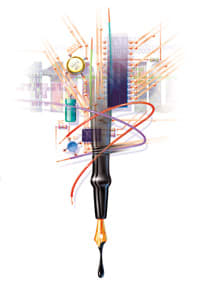the path to paperless
Building Your EMR Infrastructure
Make decisions with your long-term needs in mind.
By Peter J. Polack, M.D., F.A.C.S.
Whether you have a one-doctor, single-location practice or a multiphysician, multilocation one, the realization of an electronic medical records (EMR) system begins with the development of its physical infrastructure, or the "guts" of the system.
In most cases, the network wiring within your office and communications lines between offices will be handled by a contractor (I recommend someone certified by the Building Industry Consulting Service International (BICSI), at www.bicsi.org). It's important to familiarize yourself with specific issues and terminology. This helps to avoid surprises such as incompatible network connections or excessive labor costs because things weren't done correctly the first time.

Key Areas Demand Attention
Below, I'll examine key elements to consider in building your EMR infrastructure. If you have multiple locations, consider the needs of each separate location:
Wiring. Typical Cat5e wiring will have either a T568A or T568B standard. Pick either standard and make sure your entire practice is wired to that standard. For most practices, the newer and slightly more expensive Cat6 wiring isn't really necessary.
Copper wiring between telco (telephone/communications) closets should have segments no longer than 100 meters. For longer wiring distances, consider fiber optic cable. Although initially more expensive, fiber optic can carry more information and is less vulnerable to interference and lightning.
And make sure to overwire to meet longer-term needs. Most existing buildings are wired above the ceiling and the wiring is "dropped" down the walls. The larger cost in installing wire is labor, so everywhere you think you need a network connection, wire two drops. You'll thank yourself later when you want to add more network devices like a networked printer, a kiosk, or a hard-wired wireless access point, which has antennae to communicate with several wireless devices.
In addition, newer ophthalmic diagnostic equipment is being made with network connectivity. Consider installing network drops where you anticipate placing diagnostic equipment to facilitate future interfacing needs.
Security. Don't forget about security. Make sure you can secure the wiring closet. Remember, whoever has access to it has access to unplug your network.
Wireless. Are you considering WiFi (wireless networking)? If so, which standard do you want to run? 802.11a, 802.11b, 802.11g, or 802.11h? Different standards require different densities and locations of access points. Newer standards have higher throughput (speed of data transfer) but cost more. It also will depend on how you'll be running your software application (i.e., thin client or not). I'll discuss this in more detail in the next installment on local area network (LAN) design.
Electricity. Spend the extra money and have an electrician install isolated circuits for your network and server equipment. This is standard practice in IT and usually the outlets are orange so you can tell them apart.
Cooling. Server and network equipment generate a lot of heat and can shut down when overheated. Make sure you have adequate cooling. It may require installation of a small AC unit.
Establishing a WAN
Practices with more than one location need to establish a wide area network (WAN) connection between locations. Do your homework and make sure you know all of the options in your area. As a general rule, major metropolitan areas tend to have more options for WAN networking, including fiber backbones.
It's common practice for local utilities such as telephone and cable companies to maintain fiber backbones, and they often will allow businesses access to them. This can be a great option that offers high bandwidth (10 to 100 Mbps) between locations for very competitive rates.
Your local phone carrier's sales reps should be well versed in the current technologies offered in your area. Some points to discuss include:
►T1 lines: Which connection would be more beneficial, Point-to-Point or Metropolitan Area Network?
► Ask about "bursting" and "committed information" rates. A "fast" T1 connection may be inadequate for your needs if the maximum rate isn't available when you need it.
► Will the phone company supply and maintain the router hardware, or are you expected to do that?
Bear in mind that infrastructure costs are significantly lower in new building construction, so plan accordingly. There's a great advantage in being able to wire a new building as it's built. However, for most practices with existing buildings, it's important to design the infrastructure and network with a little forethought to save a lot of heartache later. OM
Thanks to our CIO, Warren Brown, for assisting with this article.
Next: Designing the Local Network
Peter J. Polack, M.D., F.A.C.S., is co-managing partner for Ocala Eye, PA, and a specialist in cornea, external disease and refractive surgery. Founded in 1971, Ocala Eye is a seven-partner, multisubspecialty ophthalmology practice located in Ocala, Fla. The practice, which has five locations including an ASC and laser center, has 120 employees. He can be reached by email at ppolack@ocalaeye.com.
In this multipart series, Dr. Polack will describe how a seven-partner practice, Ocala Eye in Ocala, Fla., with five locations and 120 employees, makes the major transition from paper medical records to EMR. During the course of the series, Dr. Polack will provide readers with a "real-time" look at how the implementation is progressing. This is part 4 of the series.








